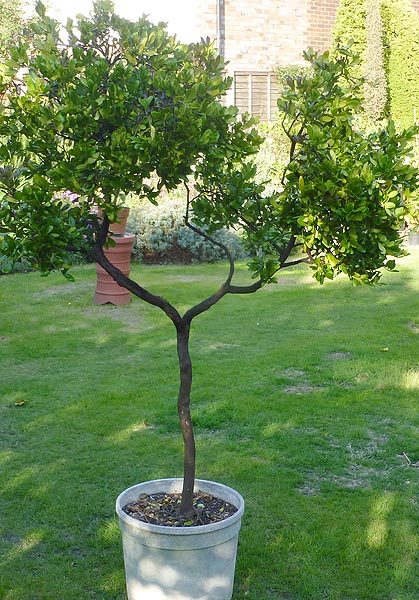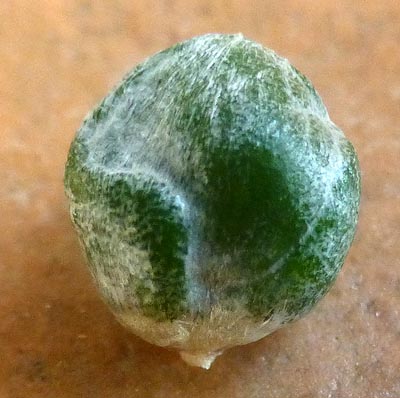








Botanists classify the true citrus as follows:
I haven't made special efforts to locate citrus relatives - there are many, and some are difficult to obtain. Moreover, I don't have enough space to grow them!
However, I do have the species described below, plus Poncirus trifoliata and its hybrids which have now been re-united into the citrus genus.
.
The Wampee is native to Southern China where it is cultivated for its fruits. There are sweet and acid forms.
Although only distantly related to citrus, the species are mutually graft compatible. Sadly, my plant succumbed to phytophthera in 2010. Replacement wanted!
Although only distantly related to citrus, the species are mutually graft compatible. Sadly, my plant succumbed to phytophthera in 2010. Replacement wanted!
Rutaceae/Citroideae/Clauseneae/Clausena
Typical compound leaf, about 30cms (12") long.
A cluster of ripe and unripe fruit at the top of the plant
Fruit close-up, each about 1.8cms in diameter.
Fruit cut open to reveal the internal soft flesh and occasional seed. Seeds have a thin skin covering green cotyledons, and a dark brown tip - the Chalazal spot.
Rutaceae/Citroideae/Citreae/citrus?
Rutaceae/Citroideae/Citreae/Severinia
Also known as 'boxthorn' this evergreen shrub is native to Southern China.
Although known to be graft compatible with citrus, my plant is growing on its own roots - either a seedling or cutting.
After many years, it produced its first flowers, which are only about 4mm across.
By 2020 it had developed into a small tree about 2m tall. It now produces small black fruits containing a single pea-sized seed.
Although known to be graft compatible with citrus, my plant is growing on its own roots - either a seedling or cutting.
After many years, it produced its first flowers, which are only about 4mm across.
By 2020 it had developed into a small tree about 2m tall. It now produces small black fruits containing a single pea-sized seed.


This is a very distant relative. Known as "Desert Rue", the whole plant has a distinctive pungent smell when brushed against, giving its common name of "Turpentinebroom". The only obvious connection to citrus is that the tiny fruit are, like citrus peel, covered in oil glands. Thamnosma is a small herbacious perennial, or sub-shrub, from California. My plant flowered after about 3 years from seed, sent to me from Rancho Santa Ana Botanic Garden (now called California Botanic Garden) but sadly did not survive the following winter.
I would like to obtain more seed and grow this species again.
I would like to obtain more seed and grow this species again.
The dark blue flowers look promising, but the petals never seem to fully open.
The fruits form in pairs, each half only about 4mm diameter
The classification of Glycosmis seems very complicated and not fully understood or agreed by different botanists.
Seeds sent to me from Australia in 2002. After two years the seedlings were about 6" (15cms) high. They showed no sign of any trifoliate leaf characteristic at that stage.
Seeds sent to me from Australia in 2002. After two years the seedlings were about 6" (15cms) high. They showed no sign of any trifoliate leaf characteristic at that stage.




page updated 20th August 2005
and 15th September 2020
and 15th September 2020
Family..................Rutaceae
Sub-family...........Citroideae
Tribe......................Citreae
Genus....................Citrus
Sub-family...........Citroideae
Tribe......................Citreae
Genus....................Citrus
Clymenia is botanically either very close to citrus, or even a true citrus. It is native to Papua New Guinea.
Seedlings initially have oak-leaf shaped leaves. Unfortunately, the seedling I was given in 2004 proved eventually to be a Kumquat, and a genuine seedling given to me in 2018 died the next winter!
Seedlings initially have oak-leaf shaped leaves. Unfortunately, the seedling I was given in 2004 proved eventually to be a Kumquat, and a genuine seedling given to me in 2018 died the next winter!



Ruta graveolens [L. strong smelling rue], commonly known as rue, common rue or herb-of-grace, is a species of Ruta grown as an ornamental plant and herb. It is native to the Balkan Peninsula. It is now grown throughout the world in gardens, especially for its bluish leaves, and sometimes for its tolerance of hot and dry soil conditions. It is also cultivated as a medicinal herb, as a condiment, and to a lesser extent as an insect repellent.
Ruta graveolens - under construction
From Wikipedia:

